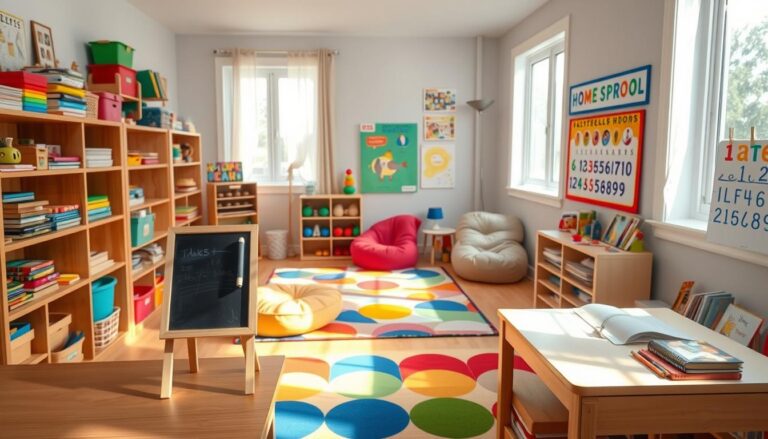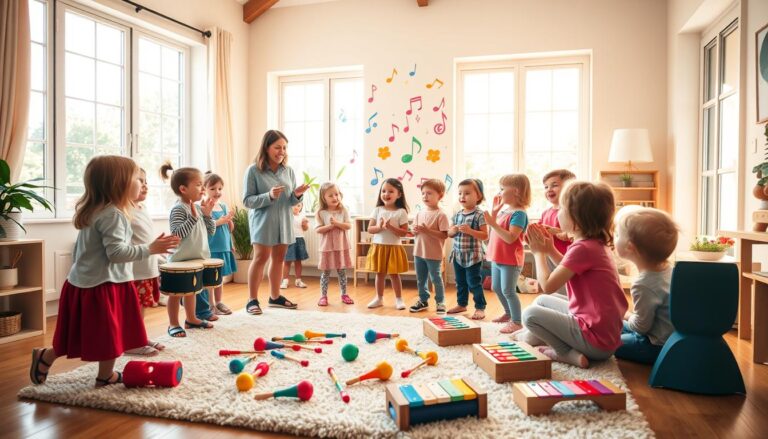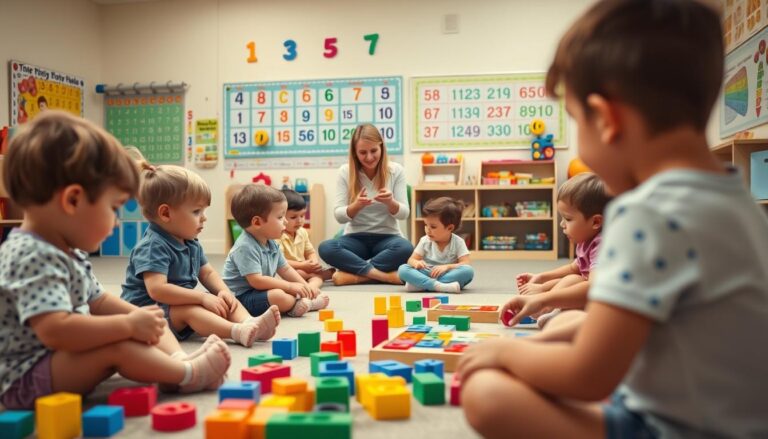Setting Up Your Home Pre-School Space: Complete Guide
Have you ever wondered how to create a nurturing environment for your child right in your own living area? Transforming a part of your family space into a dedicated learning zone is easier than you might think. We’re here to guide you through the process, step by step.
Whether you live in a compact apartment or a spacious house, our comprehensive guide shows how to blend family life with a child-friendly atmosphere. The goal is to create a space that fosters growth and creativity while maintaining comfort for everyone.
From addressing space limitations to managing budget constraints, we’ll cover all the essentials. You’ll learn how to design dual-purpose areas that serve both family and educational needs.
Let’s embark on this transformative journey together, creating a space where your child can thrive and learn every day.
Planning Your Home Preschool Setup
Creating a functional and inspiring learning area starts with a solid plan. The first step is to define your vision and goals. What do you want your child to achieve through this program? Clear objectives will guide your decisions and ensure a balanced approach to education.
Defining Your Vision and Goals
Start by outlining your educational priorities. Do you want to focus on literacy, math, or creative play? A well-rounded program includes a mix of activities to foster growth in all areas. Consider your child’s interests and learning style to tailor the experience.
Assessing Your Space and Budget
Next, evaluate the available room and resources. Measure the area you plan to use and think about how to maximize it. Flexible furniture and storage solutions can help create a multi-functional space. Budgeting is equally important—list essential materials and supplies to avoid overspending.
Designate specific areas for different activities, such as reading, art, and play. This structure helps children focus and transition smoothly between tasks. Align your program with child care needs, ensuring it fits seamlessly into your daily routine.
- Define clear educational goals to guide your planning.
- Assess your space and budget to create an effective layout.
- Select key materials and supplies for a balanced program.
- Create designated areas for reading, play, and art.
- Align the program with child care needs and education standards.
Finally, set aside specific times and days for activities. A consistent schedule provides structure while allowing room for flexibility. With thoughtful planning, you’ll create a space that supports your child’s growth and learning every day.
Designing a Nurturing Learning Environment at Home
A well-designed environment can inspire curiosity and growth in young minds. By thoughtfully arranging your space, you can create a learning-friendly atmosphere that encourages exploration and creativity. Let’s explore how to design a nurturing environment that supports both education and family life.
Creating Distinct Interest Areas
Designate specific zones for different activities to keep children engaged and focused. For example, a cozy reading nook with soft cushions can foster a love for books. An art corner with accessible supplies encourages creativity and fine motor skills. Play areas with open-ended toys promote imagination and social interaction.
These distinct zones help children transition smoothly between activities. They also provide a sense of structure, which is essential for a balanced learning environment. By organizing your space this way, you create a room that supports both structured learning and free play.
Incorporating Natural Textures and Muted Colors
Natural textures and muted colors create a calming backdrop for education and family life. Use materials like wood, cotton, and wicker to add warmth and tactile interest. Soft, neutral tones like beige, sage, and light gray help maintain a serene atmosphere.
These design choices not only enhance the aesthetics of your space but also contribute to a nurturing environment. They provide a soothing setting that allows children to focus and explore without feeling overwhelmed. As experienced providers, we recommend balancing these elements to create a welcoming and functional learning space.
Creating a Dual-Purpose Space for Teaching and Living
Balancing family life with a dedicated learning zone requires thoughtful design. Transforming a shared room into a dual-purpose area can be both challenging and rewarding. With the right strategies, you can create a space that supports education while maintaining comfort for daily living.
Utilizing Multi-Functional Furniture
Multi-functional furniture is key to maximizing space. Storage ottomans, foldable tables, and convertible seating can serve multiple purposes. For example, a storage ottoman can hold supplies during the day and double as extra seating in the evening.
These pieces help maintain a clutter-free environment, which is essential for focus and creativity. By choosing furniture that adapts to different needs, you can create a flexible and efficient space.
Defining Zones Within a Single Room
Creating distinct zones helps separate learning from family activities. Use rugs, bookshelves, or room dividers to mark different areas. A reading nook with soft cushions can be a quiet corner for focused activities, while an open play area encourages movement and interaction.
This approach ensures that each part of the room has a clear purpose. It also helps children transition smoothly between tasks, fostering a sense of structure and routine.
Maintaining Aesthetic Continuity
Color and design play a crucial role in blending the dual-purpose space. Use a cohesive color palette to create visual harmony. Soft, neutral tones like beige or light gray can make the room feel calm and inviting.
Natural textures, such as wood or cotton, add warmth and tactile interest. These elements ensure the space remains functional and visually appealing for both children and adults.
| Furniture Type | Purpose | Benefits |
|---|---|---|
| Storage Ottoman | Storage and seating | Maximizes space, reduces clutter |
| Foldable Table | Workspace and dining | Adaptable, easy to store |
| Convertible Seating | Chairs and benches | Multi-functional, space-saving |
By thoughtfully designing your dual-purpose space, you can create an environment that supports both learning and family life. With the right furniture and layout, your room can become a versatile hub for growth and connection.
Choosing Materials and Learning Resources
Selecting the right materials and resources is essential for fostering a child’s growth and creativity. The tools you choose can significantly impact their learning experience. We’ll guide you through the process of picking age-appropriate supplies that align with your educational goals.
Selecting Age-Appropriate Supplies
When choosing materials, focus on items that encourage hands-on exploration and creativity. Look for supplies that are safe, durable, and designed for young learners. Books, manipulatives, and art tools should align with your child’s developmental stage.
Consider educational philosophies like Montessori or Reggio Emilia when selecting a curriculum. These approaches emphasize self-directed learning and creativity. For example, Montessori materials often include sensory-based items like sandpaper numbers and pink towers.
Budget constraints don’t have to limit quality. Thrift stores, libraries, and discount retailers like Dollar Tree offer affordable options. Invest in key items like Crayola art supplies for their durability and long-term value.
| Material Type | Purpose | Benefits |
|---|---|---|
| Books | Literacy development | Enhances vocabulary and imagination |
| Manipulatives | Math and fine motor skills | Encourages hands-on learning |
| Art Supplies | Creative expression | Fosters creativity and problem-solving |
Rotating materials keeps the learning experience fresh and engaging. Store items in labeled containers and introduce new tools periodically. This approach maintains interest and supports skill development over time.
Thoughtful material choices underpin our overall learning approach. By selecting quality resources, we create an environment where children can thrive and succeed.
Enhancing Organization Through Effective Storage Solutions
Creative storage solutions can transform even the smallest spaces into efficient learning zones. A well-organized environment not only reduces clutter but also encourages independence and focus. By implementing smart storage ideas, you can create a space that supports both learning and play.
Implementing Creative Storage Techniques
Maximizing space starts with versatile storage options. Movable shelving, baskets, and storage ottomans are practical choices. These items help keep supplies organized while maintaining a clean and inviting environment.
Labeling storage areas with pictures and words improves accessibility. Children can easily find and return items, fostering responsibility. For example, a block storage bin with a clear label ensures quick cleanup after playtime.
- Use low, open shelves for easy access to materials.
- Incorporate storage ottomans for dual-purpose functionality.
- Label bins with both images and text for clarity.
Rotating Materials for Continued Engagement
Rotating supplies keeps the learning experience fresh and exciting. Introduce new puzzles, blocks, or art tools periodically. This approach maintains children’s interest and supports skill development over time.
Store rotated items in labeled containers for easy retrieval. A post system can help track which materials are currently in use. This method ensures a clutter-free space while keeping every item accessible.
By thoughtfully organizing your program areas, you create an environment that fosters growth and creativity. Effective storage solutions are key to maintaining a balanced and engaging learning space.
Addressing Legal and Logistical Considerations
Navigating the legal and logistical aspects of starting a learning program can feel overwhelming. However, understanding these requirements is essential to creating a safe and compliant environment. We’ll guide you through the key steps to ensure your program meets all necessary standards.
Understanding Licensing and Safety Requirements
Every city and community has specific regulations for operating a learning program. These often include licensing, background checks, and safety certifications. For example, First Aid and CPR training are mandatory in many areas, especially if you’re caring for infants.
Licensing typically involves meeting health, safety, and operational standards. This process ensures your space is secure and suitable for children. Background checks, including fingerprinting, are also required to ensure the safety of everyone involved.
It’s important to research local guidelines, as they can vary significantly. Some communities may require additional certifications, such as safe sleep training, to reduce risks like Sudden Infant Death Syndrome (SIDS).
Budgeting and Compliance Guidelines
Budgeting for compliance is a critical part of the planning process. Expenses may include licensing fees, safety equipment, and staff training. Start-up costs can range from $10,000 to $50,000, depending on your location and program size.
To manage costs, consider applying for microloans or grants. Many state initiatives offer support to licensed programs. For example, over 80% of licensed programs in the U.S. have received some form of state assistance.
| Expense Type | Estimated Cost | Purpose |
|---|---|---|
| Licensing Fees | $500-$2,000 | Legal operation |
| Safety Equipment | $1,000-$3,000 | Child protection |
| Staff Training | $500-$1,500 | Certifications |
By planning ahead, you can ensure your program remains financially sustainable. This includes setting aside funds for ongoing expenses like renewals and inspections.
We are committed to following every step in the legal process to create a secure place for learning. Our goal is to exceed standards, providing a safe and nurturing environment for children. For more detailed insights, explore our guide on setting up a learning.
Incorporating Outdoor and Flexible Learning Areas
Outdoor spaces offer a unique way to enrich a child’s learning experience. By blending indoor and outdoor activities, we create a dynamic environment that fosters curiosity and growth. This approach not only supports physical development but also enhances creativity and problem-solving skills.
Designing Engaging Outdoor Play Spaces
Outdoor play spaces should stimulate a child’s natural curiosity while complementing indoor learning areas. Incorporate varied activity stations that can be reconfigured as needed. For example, a sandpit encourages sensory exploration, while a climbing structure promotes physical development.
A dedicated set of outdoor equipment, such as balance beams or playhouses, enhances interactive learning. These tools provide opportunities for children to engage in hands-on activities that align with our curriculum. By rotating materials, we keep the experience fresh and engaging.
Creating opportunity zones where learning extends beyond four walls is essential. These areas can include nature exploration corners or open fields for group games. Scheduling day segments that alternate between indoor and outdoor environments ensures a balanced learning experience.
- Design activity stations that encourage exploration and creativity.
- Use outdoor equipment to support physical and interactive learning.
- Rotate materials to maintain engagement and interest.
- Create opportunity zones for nature-based lessons.
- Alternate indoor and outdoor activities for a balanced program.
Our family can enjoy and support this flexible arrangement by participating in outdoor activities together. This reinforces the idea that our home is a constant, dynamic learning environment. By adapting our curriculum, we ensure outdoor lessons are as structured and engaging as indoor ones.
Conclusion
Every corner of your house can become a space for growth and discovery. Our guide has walked you through every step, from planning to execution, to create a nurturing environment where your child can thrive. A well-organized space is key to fostering success and quality education, ensuring every need is met with creative solutions.
As teachers and caregivers, we prioritize the process of building a space that supports learning and play. Focus on the thing that matters most: your child’s needs. Utilize every corner, from reading nooks to play areas, to make the most of your time and resources.
With a trusted book collection and adherence to school regulations, quality child care is within reach. Take the next step in your journey and transform your house into a space where young minds flourish.







